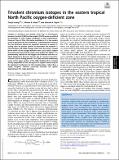Trivalent chromium isotopes in the eastern tropical North Pacific oxygen-deficient zone
Author(s)
Huang, Tianyi; Moos, Simone Beatrice; Boyle, Edward A
DownloadPublished version (946.0Kb)
Publisher Policy
Publisher Policy
Article is made available in accordance with the publisher's policy and may be subject to US copyright law. Please refer to the publisher's site for terms of use.
Terms of use
Metadata
Show full item recordAbstract
© 2021 National Academy of Sciences. All rights reserved. Changes in chromium (Cr) isotope ratios due to fractionation between trivalent [Cr(III)] and hexavalent [Cr(VI)] are being utilized by geologists to infer oxygen conditions in past environments. However, there is little information available on Cr in the modern ocean to ground-truth these inferences. Transformations between the two chromium species are important processes in oceanic Cr cycling. Here we present profiles of hexavalent and trivalent Cr concentrations and stable isotope ratios from the eastern tropical North Pacific (ETNP) oxygen-deficient zone (ODZ) which support theoretical and experimental studies that predict that lighter Cr is preferentially reduced in low-oxygen environments and that residual dissolved Cr becomes heavier due to removal of particle-reactive Cr(III) on sinking particles. The Cr(III) maximum dominantly occurs in the upper portion of the ODZ, implying that microbial activity (dependent on the sinking flux of organic matter) may be the dominant mechanism for this transformation, rather than a simple inorganic chemical conversion between the species depending on the redox potential.
Date issued
2021Department
Massachusetts Institute of Technology. Department of Earth, Atmospheric, and Planetary SciencesJournal
Proceedings of the National Academy of Sciences of the United States of America
Publisher
Proceedings of the National Academy of Sciences